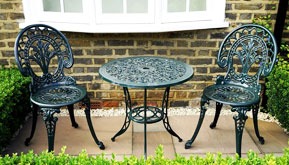When choosing furniture for the outdoor parts of your home like the patio and backyard, its ideal to pick those made of durable materials which can withstand any weather conditions. One common material great for outdoor settings is cast iron, and cast iron furniture make patios and backyards look elegant and beautiful.
What is cast iron?
Cast iron, despite the name, is not purely made up of iron. It’s actually an iron alloy with 2-5 percent carbon, silicon, manganese, as well as traces of sulfur and phosphorus.
Cast iron is formed by smelting iron ore and mixing it with other metal alloys. If forms a liquid mixture that is eventually poured out on molds to take shape and then left to cool and solidify. The solidified mixture usually creates a hard, heavy and strong and non-malleable piece of metal but it can be brittle. Fortunately, there are some types of cast iron that are malleable or can be bent or hammered into shape.
Grey cast iron is the more common and traditional type of cast iron. Its carbon content is in the form of flakes distributed throughout the metal. Grey cast iron is the non-malleable type, and it is strong and heavy but not as durable for home use. Meanwhile, a more malleable type is the white cast iron, wherein the carbon content is chemically combined as carbide of iron. It is known for its superior strength. Cast iron is used for many home applications such as cookware and furniture.
 Cast iron furniture
Cast iron furniture
Cast iron furniture has been popular during the mid-1800s to 1890s because ironworkers became more skillful in creating decorative cast irons. The interest in Victorian-styled gardens was also at its peak at that time, creating a public demand for these types of furniture. Back then it was an economical choice and replaced the more expensive wrought-iron that was widely used during the early 1800s. By the coming of the 20th century, steel eventually replaced cast iron in popularity and use.
Because cast iron furniture was heavy, manufacturers usually divided them into smaller castings (each individually boxed) and then assembled by the buyer.
During the mid-1900s, cast iron furniture was being widely reproduced, copying vintage originals. It is still being manufactured today for different structural and decorative purposes. But since then, it became a relatively expensive choice, because there are many other products available that are made from cheaper materials. The durability of cast iron makes furniture last for a long time, but it can still rust when paint chips.
Typically cast iron furniture features patterns like lacework, vintage florals and classic motifs such as vines and fruits. It is used in outdoor settings of homes such as:
- Garden furniture – small dining sets, benches, chairs
- Gates and fences
- Birdbaths
- Planters
- Decorative items like fountains
To check if a cast iron furniture is authentic, try to carry it if it is heavy. If it is, it’s more likely made of cast iron (but don’t depend on weight only). Look for the manufacturer’s marks or stamps and check its history.
Older cast iron furniture usually has holes on each piece that are drilled or cast for joining pieces together. Nuts and bolts (which can be flat head or round head) are used to fasten the parts. Newer reproductions, meanwhile, have only one hole in one of the mating pieces. The holes are designed to fit over a permanently embedded stud on the other parts. Nuts and bearings are used to fasten these pieces together.
Care and maintenance for cast iron furniture
Like many other types of furniture, you need to take care of cast iron furniture to keep them beautiful and functional. First off, you can maintain its good appearance and condition by keeping it covered during rainy and snowy days, and also during very sunny days when the metal can really heat up.
Here are some other maintenance tips:
1. Cleaning
To clean cast iron furniture, you only need a brush and a solution of water and gentle detergent to scrub the dirt away.
2. Removing rust
For furniture with a small amount of rust, rub the affected areas with sandpaper and wipe it down afterward. If there is a major rust build-up, you can remove it manually with a wire brush or apply some chemical rust remover. Rub away any peeling paint if the furniture is painted. Then you can clean it with water and detergent, or use a power wash system.
3. Painting
Cast iron furniture can be left unpainted, but most homeowners like them painted. To paint, apply two coats of primer (with each coat completely dried), then two coats of oil paint or spray paint. It is best to use rust-inhibiting metal paints. Leave it for a few days to dry completely. Finally, you can add a finishing touch to protect the paint and make it smooth. You can use polish, wax or polyurethane spray.
4. Oiling
Cast iron furniture that is connected with joints, nuts, bolts or bearings should be oiled periodically to keep them in good working order. Apply oil after and not before painting, since paint may not stick to the surface if it has been oiled first.


